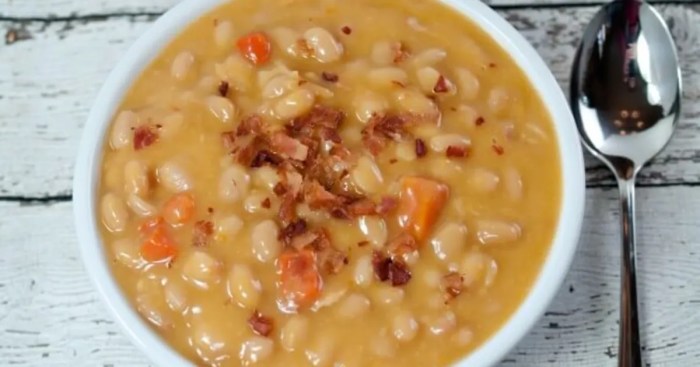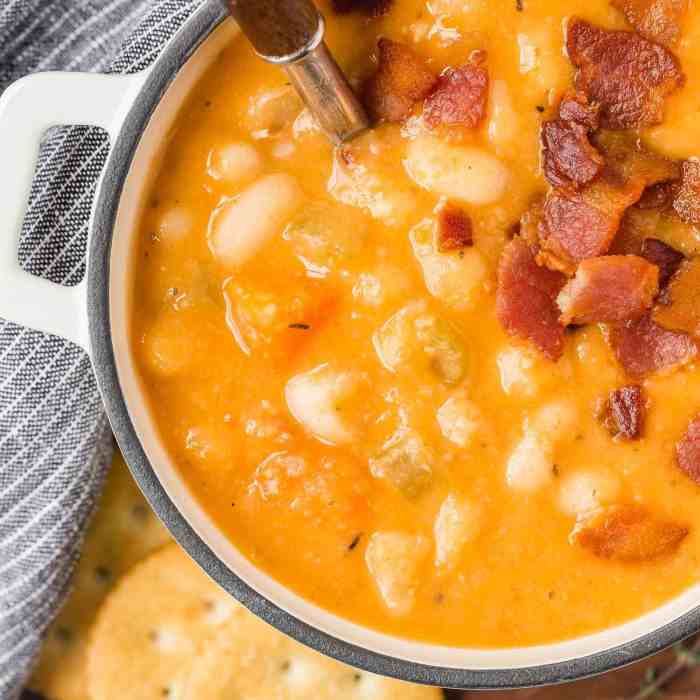Recipe Variations: Campbell’s-Style Bean and Bacon Soup
Bean and bacon soup recipe like campbells – This section explores three variations on a classic bean and bacon soup, drawing inspiration from the familiar flavors of Campbell’s. Each variation highlights a different bean type, offering unique textural and flavor profiles. We’ll also delve into recipes emphasizing smoky bacon, slow-cooked bacon for enhanced depth, and a lower-sodium option that retains rich taste.
Kidney Bean Variation
This recipe uses kidney beans for their hearty texture and slightly earthy flavor. The smoky bacon complements the kidney beans beautifully.
- 1 lb kidney beans, soaked overnight
- 6 slices thick-cut bacon, diced
- 1 onion, chopped
- 2 carrots, diced
- 4 cups vegetable broth
- 1 tsp smoked paprika
- Salt and pepper to taste
Pinto Bean Variation
Pinto beans offer a creamier texture and milder flavor compared to kidney beans, creating a gentler soup experience. This variation focuses on balancing the mildness of the beans with the robust flavor of bacon.
- 1 lb pinto beans, soaked overnight
- 4 slices center-cut bacon, chopped
- 1 celery stalk, chopped
- 1 green bell pepper, chopped
- 4 cups chicken broth
- 1/2 tsp cumin
- Salt and pepper to taste
Black Bean Variation (Low Sodium), Bean and bacon soup recipe like campbells
This variation uses black beans for their unique flavor and lower sodium ingredients to create a healthier, yet flavorful soup. We’ll achieve a rich taste without relying heavily on salt.
- 1 lb black beans, rinsed
- 4 slices turkey bacon, chopped (or unsmoked bacon)
- 1 onion, chopped
- 1 red bell pepper, chopped
- 4 cups low-sodium vegetable broth
- 1 tsp chili powder
- 1/2 tsp garlic powder
- Black pepper to taste
Smoky Bacon Focused Recipe
This recipe emphasizes the smoky flavor of bacon by using smoked bacon and incorporating smoky paprika for an intensified smoky profile.
- 1 lb mixed beans (kidney, pinto, black), soaked overnight
- 8 slices smoked bacon, diced
- 1 large onion, chopped
- 2 cloves garlic, minced
- 4 cups beef broth
- 1 tbsp smoked paprika
- 1 tsp liquid smoke (optional)
- Salt and pepper to taste
Slow-Cooked Bacon Recipe
Slow cooking the bacon enhances its flavor, rendering out more fat and creating a deeper, richer taste that infuses the entire soup.
- 1 lb navy beans, soaked overnight
- 6 slices thick-cut bacon, cooked until crispy and rendered, then chopped
- 1 onion, chopped
- 2 carrots, diced
- 4 cups chicken broth
- 1 bay leaf
- Salt and pepper to taste
Ingredient Exploration: Key Components of the Soup
Understanding the role of each ingredient is crucial for creating a well-balanced and flavorful bean and bacon soup. This section explores the impact of different beans, bacon cuts, vegetable preparation, and potential bacon substitutes.
The Role of Beans
Different beans contribute unique textures and flavors. Kidney beans provide heartiness, pinto beans offer creaminess, and black beans add a subtle earthiness. The choice of bean significantly impacts the overall mouthfeel and taste of the soup.
Bacon Cut Selection
Thick-cut bacon renders more fat, resulting in a richer, more flavorful soup. Center-cut bacon provides a good balance of flavor and crispiness. The choice depends on personal preference for fat content and texture.
Vegetable Preparation
Proper vegetable preparation enhances the soup’s overall quality. Diced vegetables cook evenly, while roasting vegetables before adding them to the soup adds depth of flavor and caramelization.
Bacon Alternatives

Source: whisk.com
For vegetarians or those with dietary restrictions, several alternatives can replace bacon. Smoked tempeh, mushrooms (e.g., cremini or portobello), or smoked tofu can provide similar smoky and savory notes.
Cooking Methods and Techniques: Achieving Campbell’s-like Consistency
This section compares stovetop and slow-cooker methods, guides you through creating a smooth and creamy soup, and details techniques for thickening the soup to achieve the desired Campbell’s-like consistency.
Stovetop vs. Slow Cooker
Stovetop methods offer quicker cooking times, while slow cookers provide a more hands-off approach and allow for deeper flavor development. Both methods can yield delicious results, depending on your time constraints and preferences.
Creating a Creamy Soup
An immersion blender is ideal for creating a smooth and creamy texture without transferring the soup to a regular blender. Simply blend the soup directly in the pot until the desired consistency is reached.
Thickening Techniques
A roux (butter and flour mixture) or a cornstarch slurry (cornstarch mixed with cold water) can be used to thicken the soup. The roux provides a richer flavor, while the cornstarch slurry is a quicker and simpler method.
Simmering Time
Simmering time influences the texture and flavor of both the beans and bacon. Longer simmering times result in more tender beans and a deeper, richer bacon flavor.
Presentation and Serving Suggestions: Enhancing the Dining Experience
The presentation of your bean and bacon soup can significantly enhance the dining experience. This section offers visually appealing serving suggestions, nutritional information, bread pairings, and a descriptive image.
Serving Suggestions
Garnish with fresh herbs (parsley, chives), a swirl of crème fraîche or sour cream, or crispy bacon bits for added visual appeal and flavor.
- Garnish with chopped fresh parsley and a dollop of sour cream.
- Serve with a side of crusty bread for dipping.
- Top with crispy fried onions for added texture and flavor.
Nutritional Information
| Variation | Calories (per serving) | Protein (per serving) | Fat (per serving) | Carbohydrates (per serving) |
|---|---|---|---|---|
| Kidney Bean | 250 | 15g | 12g | 30g |
| Pinto Bean | 230 | 14g | 10g | 32g |
| Black Bean (Low Sodium) | 200 | 12g | 8g | 35g |
Bread Pairings
Crusty bread, cornbread, or sourdough bread all complement the hearty flavors of the bean and bacon soup.
Image Description
A steaming bowl of bean and bacon soup, rich mahogany in color, is presented. The texture appears thick and creamy, with visible pieces of bacon and tender beans. The aroma is a delightful blend of smoky bacon, savory beans, and subtle spices.
Recipe Troubleshooting and Tips: Avoiding Common Mistakes: Bean And Bacon Soup Recipe Like Campbells
This section addresses common mistakes, provides tips for balancing flavors, shares advice on storage, and explains how to adjust the recipe for different spice preferences.
Common Mistakes
- Overcooked beans: Soak beans properly and monitor cooking time to avoid mushy beans.
- Undercooked bacon: Ensure bacon is cooked to your desired crispiness.
- Inconsistent seasoning: Taste and adjust seasoning throughout the cooking process.
Flavor Balance

Source: rachelcooks.com
Crafting a hearty bean and bacon soup reminiscent of Campbell’s requires careful attention to seasoning. For a contrasting flavor profile, consider incorporating elements from a different soup entirely, such as the vibrant spices found in a spicy pumpkin soup recipe. The warmth of pumpkin spices could offer an interesting twist to the classic bean and bacon, perhaps even inspiring a unique variation on the traditional recipe.
Taste the soup frequently and adjust salt, pepper, and other seasonings as needed. Start with less salt and add more gradually to avoid an overly salty soup.
Storage
Allow the soup to cool completely before storing it in airtight containers in the refrigerator for up to 4 days or in the freezer for up to 3 months.
Spice Adjustments
Feel free to adjust the amount of spices to your liking. Add more chili powder for a spicier soup, or more herbs for a more herbaceous flavor profile.
FAQ Compilation
Can I use canned beans?
Yes, canned beans are a convenient option. Rinse them thoroughly before adding them to the soup to remove excess sodium.
How long can I store leftover soup?
Store leftover soup in an airtight container in the refrigerator for up to 4 days.
What if my soup is too thick?
Thin the soup by adding a little broth or water, stirring until it reaches your desired consistency.
Can I freeze this soup?
Yes, this soup freezes well. Allow it to cool completely before freezing in airtight containers for up to 3 months.
